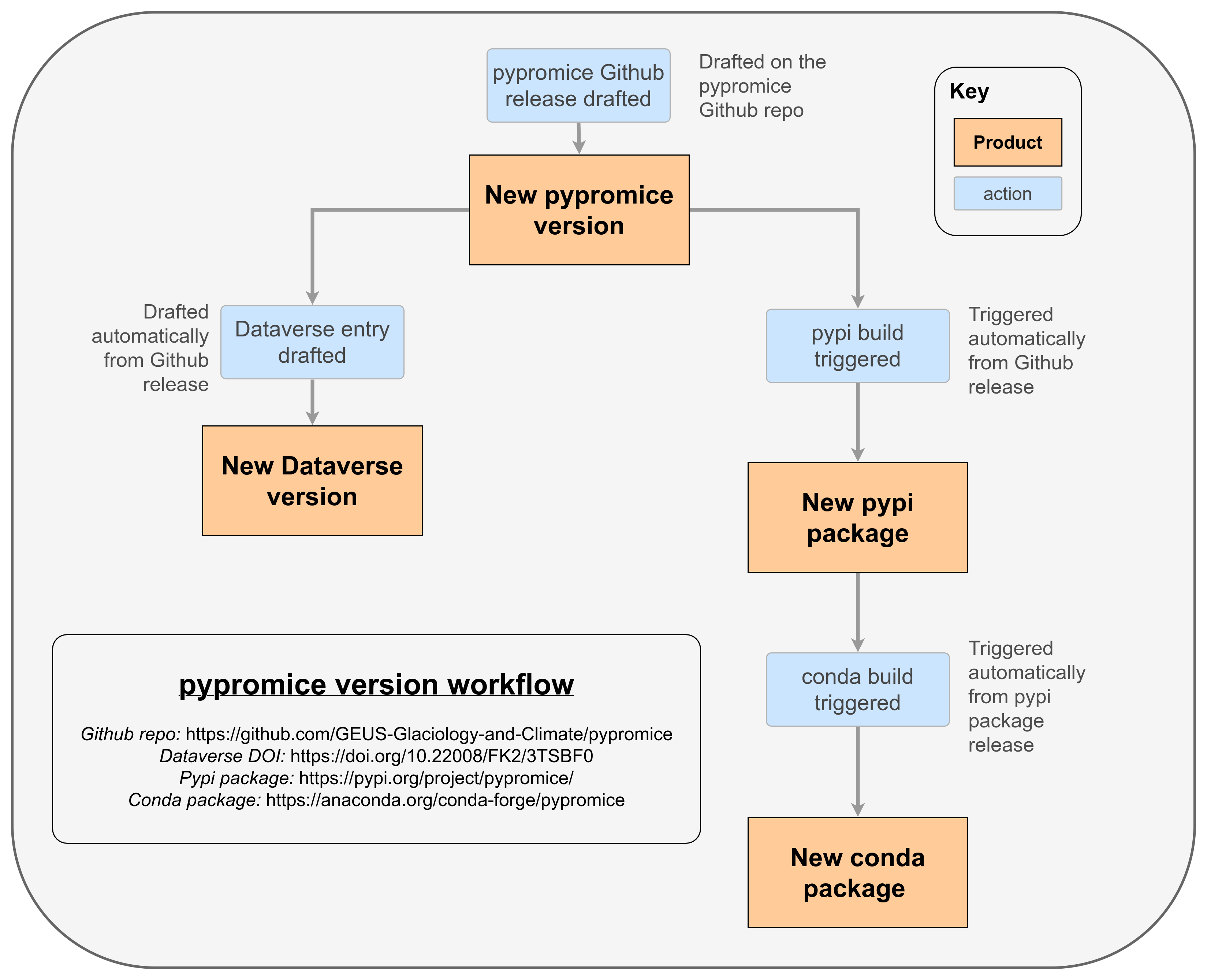Things to do before and after a new pypromice release
Most of our continual integration is automated, as shown below. But there are a couple of things that need to be checked at each step to ensure that everything is approved, released, and runs smoothly.

1. Change the pypromice package version
When a new pypromice version is due, make a new branch on the pypromice Github repo and change the version in the setup.py file. Remember to use semantic versioning, specifying a major (e.g. v1.0.0), minor (e.g.v0.1.0) or patch (e.g. v0.0.1) version depending on the nature of the updates to pypromice
2. Make a PR to the main branch
Make a pull request (PR) and merge it with the main branch once all checks have passed and someone else has reviewed it
3. Make a new pypromice release
Make a new pypromice release. The naming convention for these releases are:
- Title:
pypromice v<version>e.g.pypromice v1.0.0 - Tag:
v<version>e.g.v1.0.0
You can auto-generate the release notes, which will contain all merged PRs since the last release. Releases should always be set as the latest release
4. Check the pypromice pypi distribution is built and uploaded
The pypi distribution of pypromice should automatically be built and uploaded after a release is published. Check that the Github Action for this has run successfully here. If it has not run successfully, it could be:
- You have not updated the version in the setup.py, and pypi cannot overwrite versions. If this has happened, delete the existing release you made, update the version in setup.py in a new PR, and make a new release
- The API token for pypi has expired. This should be updated in pypi and in the Github repo secrets
5. Check the pypromice Dataverse entry is updated and publish
The GEUS Dataverse pypromice entry should also automatically update with the latest version after a pypromice release is published. This will create a new draft release in the GEUS Dataverse. Check the draft, then update the title to reflect the latest version:
- Title:
pypromice v<version>e.g.pypromice v1.0.0
Update the authorship list and metadata if needed, and then publish the update.
6. Update the pypromice conda feedstock
The pypromice conda feedstock contains the conda-forge build for pypromice (which is available here). The new pypi version will automatically be detected in the feedstock and create a new PR for you to review. If you are not happy with the build then you can always make the build yourself and open a new PR on a branch, using the grayskull package as so:
grayskull pypi pypromice
This will generate the meta.yaml file based on the latest pypi release of pypromice. It is mainly the version and sha256 entries that will be changed with the updates. Once generated, make sure that the tests and meta information is also updated. Note the import and command tests (needed to test the conda build), and the links and description.
test:
imports:
- pypromice
commands:
- pip check
- python -m unittest discover pypromice
- get_promice_data --help
- get_l0tx --help
- get_l3 --help
- join_l3 --help
- get_watsontx --help
- get_msg --help
requires:
- pip
about:
home: https://github.com/GEUS-Glaciology-and-Climate/pypromice
summary: A toolbox for handling and processing PROMICE (Programme for \
Monitoring of the Greenland Ice Sheet) and GC-Net (Greenland Climate \
Network) automated weather station data
license: GPL-2.0
license_file: LICENSE.txt
doc_url: https://pypromice.readthedocs.io
dev_url: https://github.com/GEUS-Glaciology-and-Climate/pypromice
Once all checks have passed and the branch has been merged, then the new conda package version should be built.